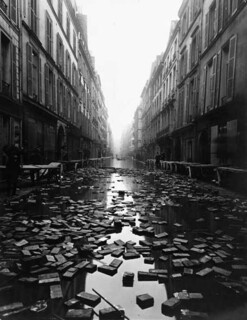The Seine Also Rises
Chris Newens
For several days now, the Seine has been drawing a crowd. The international press, tourists and Parisians have come to look at the river because it is uncharacteristically high. Before I had seen it myself, I assumed the reason for all the curiosity was novelty. We’ve been told that the chances of the river breaking its banks are extremely low, but Paris can so easily be mistaken for a city frozen in time that changes in its landscape, even temporary ones, ask to be witnessed.
Setting eyes on the engorged river, though, mud brown and churning viciously around the bare branches of its towpath trees, stirred in me an unease I had not expected: that one day, though probably not today, the Seine may begin rising like this, and not stop. And it reminded me that Parisians have long harboured a fear of their city ending up underwater.
I have read about this in poetry and seen it in art. And Laurence Osborne’s Paris Dreambook (1990) begins with a fantasy of the city drowning:
At first there was no sound as the water rose from the drains, lapped over the kerbs and restaurant doors, spilled untidily into the underground stations and filled up the cavities between the platforms … And as the oily slime made its way into the shops, garages and concierge’s lounges the population took themselves screaming to the rooftops. Everywhere clinging to makeshift rafts, scampering like rodents up church facades and famous monuments … The city finally went under, all except for the proud tip of the Eiffel Tower.
I found the scenes that Osborne describes easy to visualise, because I had seen them before. Not quite on the cataclysmic scale that Osborne imagines, but in photographs of the great flood of 1910, when the Seine burst its banks, and for a number of months, Haussmann's boulevards filled with water and Paris was a city transformed.
Parisians fear another ‘crue centennale’, a 100-year flood, which they say is long overdue. And it will happen again: Paris was built on a floodplain and the weather will only behave itself for so long.
The fear of a drowned Paris is a fear for the submergence of all cities. Its star may have waned in the last fifty to a hundred years, but there are few places more synonymous with the perceived triumph of Western civilisation. (And it is where the most recent international agreement on climate change was signed.) To see it returned to the waves, to imagine fish swimming the corridors of the Louvre or octopuses nestling in the gargoyles of Notre Dame, is to contemplate the end of all things.

Comments
At the same time, France is still the land of infrastructure, and one reason the flood of 1910 won't happen again soon is that a massive water management system has since been constructed upstream of Paris. There is now talk of extending this, digging artificial reservoirs where water can be drawn off in extreme situations, and so on. I'm selfishly hoping this will keep the waters at bay at least during my lifetime.
The moral of the lecture was not to mistake statistics for predictions, and in addition, not to trust 100-year or 500-year claims in the New World — by definition, there is not enough data to go on!
Paris, however, is not doing so well this time and the rats are indeed climbing buildings after being flushed from the drains -- and Franciliens are worried they're on the march all over.